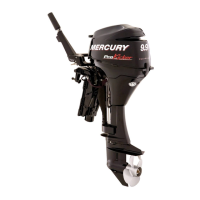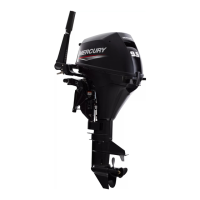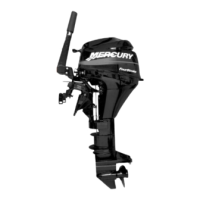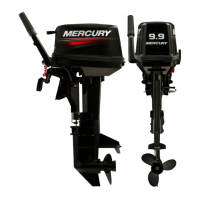
Do you have a question about the Mercury 9.9 Bigfoot 4-Stroke and is the answer not in the manual?
| Engine Type | 4-Stroke |
|---|---|
| Horsepower | 9.9 HP |
| Fuel Type | Gasoline |
| Gear Ratio | 2.42:1 |
| Starting System | Manual |
| Cylinders | 2 |
| Steering | Tiller |
| Full Throttle RPM Range | 5000-6000 RPM |
| Alternator Output | 6 Amps |
| Oil Capacity | 0.8 L |
| Displacement | 208 cc |
| Shaft Length | 20 in (508 mm) |
| Starting | Electric / Manual |
| Fuel Induction System | Carbureted |
Details compliance with EU directives for recreational craft, as amended.
Outlines requirements for recreational craft when CE mark is not accompanied by a notified body.
Covers safety integration principles for machinery and products.
Specifies standards related to noise emissions from machinery.
Addresses standards for vibration levels in machinery.
Defines standards for electromagnetic emissions from products.
Defines standards for immunity to electromagnetic disturbances.
Outlines requirements for testing against electrostatic discharge.
Explains the process and conditions for transferring the limited warranty to a new owner.
Details the procedure for registering the product for warranty in the US and Canada.
Outlines the warranty registration process for customers outside the US and Canada.
Details the warranty coverage for new products in the US, Canada, and Europe.
Outlines warranty terms for specific regions including CIS, Middle East, and Africa.
Specifies the warranty coverage period for corrosion-related issues.
Clarifies what is covered and excluded under the product's warranty.
Describes the various controls and features associated with the tiller handle.
Details the functions and operations of the remote control systems.
Explains the engine's warning system, including oil pressure lights and guardian system.
Outlines crucial steps for preparing the outboard for out-of-season or prolonged storage.
Guidance on protecting the outboard's exterior parts during storage.
Instructions for safeguarding the internal engine components during storage.
Procedures for gearcase maintenance related to storage.
Recommended positions for storing the outboard to prevent damage.
Guidelines for proper storage of the outboard's battery.
Lists possible causes and solutions when the electric start motor fails to crank.
Provides common reasons and remedies for an engine that fails to start.
Addresses issues causing the engine to run unevenly or inconsistently.
Explains potential causes for a reduction in the outboard's performance.
Lists common issues that prevent the battery from maintaining its charge.
Advice on returning the outboard to the authorized dealer for servicing.
Guidance for obtaining service when away from the local dealer.
How to inquire about genuine replacement parts and accessories.
Steps to follow for obtaining assistance with product questions or concerns.
Contact information for Mercury Marine service offices in various regions.
Defines the operator's duties for safe boat operation and passenger safety.
Provides essential reading and familiarization steps before using the outboard.
Warns about the dangers of exceeding a boat's maximum horsepower rating.
Guidance for operating boats at high speeds or with performance-oriented configurations.
Information specific to outboards equipped with remote control systems.
Important safety notice regarding the securing of remote steering components.
Explains the function and operation of the lanyard stop switch for safety.
Safety precautions for preventing injury to individuals in the water.
Specific safety advice for passengers on pontoon and deck boats.
Safety instructions for occupants on open front decks.
Safety advice for seats mounted on raised fishing platforms.
Hazards and safety considerations associated with jumping waves or wakes.
Guidance on avoiding damage and injury when striking underwater objects.
Information on exhaust emissions and carbon monoxide poisoning awareness.
Specific safety instructions for outboards operated with a hand tiller.
Risks associated with poor ventilation and carbon monoxide exposure.
General advice and recommendations for safe boating practices.
Importance and location of the outboard's serial number for future reference.
Technical specifications for the 8/9.9 4-Stroke outboard models.
Diagrams identifying key components on the standard model outboard.
Identifies controls and components on the front view of the outboard.
Identifies controls and components on the port view of the outboard.
Diagrams identifying key components on the Bigfoot model outboard.
Step-by-step instructions for properly mounting the outboard onto a boat's transom.
Guidelines for mounting and securing the battery for electric start models.
Procedures for correctly connecting and disconnecting outboard battery cables.
Advice on choosing the appropriate propeller for optimal performance.
Instructions for safe handling and transport of the outboard when detached from the boat.
Safety guidelines and procedures for transporting portable fuel tanks.
Specific instructions for trailering boats with power tilt outboards.
Specific instructions for trailering boats with outboards without power tilt.
Guidance on selecting the correct type and grade of gasoline for the engine.
Instructions and safety precautions for filling the fuel tank.
Specifies the recommended engine oil viscosity and API classifications.
Step-by-step procedure for checking the engine oil level.
Describes the various controls and features associated with the tiller handle.
Explains how to use the tiller handle lock cap for securing the handle.
Explains the use of the starter rope for manual engine starting.
Describes the function of the engine stop switch.
Explains the operation of the power tilt switch.
Details how to adjust the friction on the throttle grip for speed control.
Explains the function of the throttle-only button for neutral operation.
Describes the throttle grip's role in controlling engine speed and shifting.
Instructions for using the choke when starting a cold engine.
Instructions for using the fuel primer for cold engine starts.
Explains the function of the low oil pressure warning light and its effect on engine RPM.
Describes how to operate the electric start button.
How to adjust the steering friction lever on the tiller handle.
Explains how to lock the engine in the full tilt position.
How to use the trim position knob to pre-set the trim position.
Function of the kicker strap on power tilt models.
Details on various Mercury/Quicksilver remote control functions.
Explains the function and operation of the power tilt system.
Step-by-step guide for tilting the outboard up or down.
How to engage and use the tilt support lever.
How to adjust the vertical angle of the outboard for optimal performance.
Instructions for adjusting the transom angle of the outboard.
How to use shallow water drive positions for operating in shallow water.
Detailed procedure for tilting the outboard to its full up position and locking it.
How to adjust the trim tab to compensate for steering torque.
Essential checks to perform before starting the engine.
Precautions and procedures for operating in freezing conditions.
Recommendations for flushing and maintenance after use in salt or polluted water.
Specific considerations when using the outboard as an auxiliary power source.
Initial steps to take before starting the engine.
Critical steps for breaking in the engine to ensure longevity.
Step-by-step guide for starting the engine on tiller handle models.
General guidance for keeping the outboard in optimal operating condition.
Recommendation for using genuine Mercury or Quicksilver parts and lubricants.
Information on the emission certification label and owner responsibility for maintenance.
Lists periodic inspections and maintenance tasks required for the outboard.
Maintenance tasks recommended every 100 hours or annually.
Maintenance tasks recommended every 300 hours or three years.
Procedure for flushing the outboard's cooling system with fresh water.
Instructions for removing and reinstalling the outboard's top cowl.
Periodic inspection of the battery to ensure proper engine starting capability.
Guidance on cleaning and waxing the outboard's exterior finish.
Safety precautions and instructions for servicing the fuel system.
Visual inspection of the fuel line and primer bulb for damage or wear.
Instructions for inspecting and replacing the fuel line filter.
Importance of using correct fasteners for steering link rods and safety warning.
Explanation of the anode's function and the need for periodic inspection and replacement.
Step-by-step guide for replacing the outboard's propeller.
Instructions for replacing fuses in the electric starting circuit.
Procedure for inspecting, gapping, and replacing spark plugs.
Guidelines for inspecting the timing belt for signs of wear or damage.
Procedure for changing the engine oil and its capacity.
Details on specific points requiring lubrication and recommended lubricants.
Instructions for lubricating throttle/shift cables and related components.
Procedure for lubricating steering cable grease fittings.
Procedures for checking, draining, and refilling gearcase lubricant.
Steps for checking and refilling the gearcase lubricant level.
Procedure for checking the fluid level in the power tilt system.
Immediate service requirements for an outboard that has been submerged in water.












